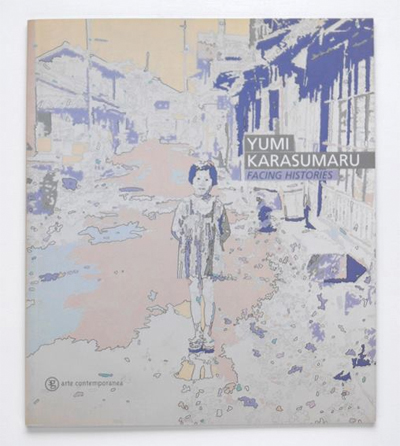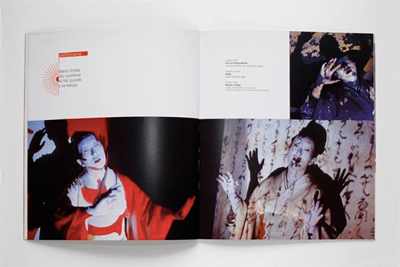From the catalog of the personal exhibition "Facing Histories",
Teatro Nuovo Giovanna da Udine, Udine, Italy 2004

Facing Histories
by Sabrina Zannier
The past and the present, history and actuality,these are the two extremes that communicate at a distance.The social and cultural reservoir of today, by force of circumstances,contains the past or, at least, it has to square things out with the past whether in the light of more or less awareness. Notwithstanding this aspect,when the works of an artist extend into the social front, they are usually based on the artist’s experience in life and the close contemporaneity that directly restores that link with the past, the present or the remote, whatever it may be,without questioning or creating problems. In other words, it is difficult to meet someone who understands and knows how to constantly trigger-off that distant line of communication between the past and the present.When something like this happens,it is usually done by someone who has personally experienced distance in geographical terms,which nevertheless, also includes temporal distance.The is to say,artists who have left their country of origin,perhaps forced by difficult,if not terribile,conditions of life and who,suffering from such a detachment,tend to produce works of art with a strong social-political bearing, laying critical emphasis and with hints of rage and violence. This is certainly not the case of Yumi Karasumaru, who decided to leave Japan of her own choice to live in Italy. She also did it to observe and “hear” her country from afar, to look at it from two different viewpoints: that of the closeness to a different country from her country of origin and that of this distance from her country. This double viewpoint is what has probably helped her to find the persevering line of communication between the past, i.e. distance, and the present, i.e. closeness, as the inspiration for her works, being deep-rooted in Japan’s identity, which is set between tradition and the hyperbolic technological and commercial development that on a future key cultivates the different aspects of life. In short, if this guiding line is innate, given that Yumi is Japanese, it is also the result of her individual artistic identity, which is able to restore the link between past and present without inscribing violent social criticism or political bearing. Her art belongs to a certain lightness in the expression of profoundness, painful events, such as war in the series relating to the atomic bomb, social problems like those relating to sects or, still further, progress that frustrates the attempt to strengthen identity, with a palette of light colours, a sensory pleasantness and, why not, a slight hint of pop art. This capacity is also enhanced by the principle of distance in which the artist has individualised the wide space of reflection and criticism. A distance between photographs that have been found or have been taken personally and paintings created from these. It is as if Yumi is rewriting history and the present with her own vocabulary taken from the calligraphic and pictorial Japanese traditions and, at the same time, form the imaginary pop and technological art of the West, but now also of the East. A vocabulary that in painting is characterised by a finesse in which the bright and, in some cases, acid colours of the last few years of the nineties have moved towards a softer direction with more pastel and paler colours and in increase in the pictorial surface. A vocabulary that consists of many languages, form painting to photography, form video to performance, but nevertheless characterised by a suggestive fusion between human figures and the surrounding environment that are so contaminated that they appear to be levelled out by the same signic and chromatic material, as well as the same emotional atmosphere.
Facing Histories, which is not only the title of this exhibition, but also of another personal exhibition by Yumi, because this is how all her works could be entitled, tells us about the story of faces, faces that tell stories, that allude and travel along the paths of time; stories from the past that have been lived at a distance, in temporal as well as geographical terms, and contemporary stories relating to the present, which has already become history when it is thought of and reflected in images. Yumi Karasumaru’s works are full of recollections and recreations on and about history; the individual history of her family, and the joint history of Japan seen from the East and the West at the same time.
In the series relating to the Hiroshima and Nagasaki bomb, starting from the archetype of the atomic mushroom, the bright and ironically caramel colours refer not only to the real colours of the explosion, but also bring to mind those of the traditional kimono and likewise those of plastic and glossy magazines, almost as if they were pleasant sensorial platforms conveying an expression and story full of tragedy and pain. In the series of photographs entitled A+B, personal identity added to joint identity gives a sort of mathematical-subjective flow, therefore, in a play of masks, the artist’s face is added to other faces from the past, from religion or the present; from Buddah she passes over to the comic-strip superheroes in a visual and sensorial short-circuit in which the memory is revitalised by an acute critical awareness of the present.
Going back to painting,the most recent works in the cycle relating to the family and teenager of today’s Tokyo concern the above mentioned deviation,which indicates a parallelism with the paintings of the atomic bomb as regards the relationship between the contents and the colours.While in this case,the dramatic sense of history rethought by the artist,was in some way “enlightened” by the bright colours and acidity that also recall the neon signs of a metropolis of fun and enjoyment,the case of the family figures,like a traditional and comforting album of homely memoires, and the free-and-easy,fresh and capturing attitude of the teenagers, full of pastel colours,which at time fade away to leave the white colour of milky atmospheres, appear to be tinged with a subtle melancholy, a sort of caressing breeze that stores the family history and the present into a section of the memory, a recollection living along that temporal and geographical distance that links Yumi’s entire research. A melancholy that puts you out of place ,that does not give reassurance but causes uncertainty in the vision and thought of yesterday’s and today’s existence. Another direction of the artist in her last few works of art concerns the relationship between colour and sign,the latter of which gains ground as a sort of refined “embroidery” that intensifies the conceptual value of painting as an analysis of individual or joint identity,driving the sharp “needle-paintbrush” into that complex and fine line between the excess in identity,based on gadgets,clothing and all the symbols of contemporary consumerism,and the frustration of one’s personal identity subjected to the risk of such excess.
di Sabrina Zannier
Storie di volti — che alludono ad altre storie, del passato collettivo e individuale, ma anche del presente — intrecciano le complesse trame identitarie di una storia tesa fra Oriente e Occidente, tra il nativo Giappone e l'Italia, dove Yumi Karasumaru ha deciso di vivere e condurre la sua costante ricerca artistica. Una storia intrisa di profondo radicamento alla tradizione e di iperbolico sviluppo tecnologico e commerciale che nutre in chiave futuribile diversi aspetti del vissuto quotidiano. La prima personale dell'artista a Trento s'intitola Facing Histories vol. 3 perché riguarda una narrazione per immagini suddivisa in tomi, che non sono libri ma mostre, di volta in volta diverse seppur intitolate allo stesso modo. Questa è la terza del ciclo; raccoglie una sola parte della produzione di Karasumaru, quella pittorica, caratterizzata anche da video, performance e fotografie.
Vol. 3 di Facing Histories è una breve ma intensa carrellata di volti di bimbi, fratelli, scolari, ragazzine, famiglie, che ci guardano dritti negli occhi come si fa innanzi a un obiettivo. Sono volti immortalati in immagini fotografiche scattate o trovate dall'artista, poi traslati in dipinti a china, acrilici, matita, su tela secondo un vocabolario pittorico che ammicca alla preziosità della tradizione calligrafica giapponese e, al contempo, all'immaginario pop e tecnologico tanto dell'Occidente quanto dell'Oriente contemporaneo. Da questa commistione nasce la singolarità di un'opera in cui gli intensi cromatismi — acidificati o edulcorati negli anni Novanta, poi aerati in tavolozze pastellate e lattiginose — sono animati da un segno virgolato e arricciato come una sorta di "raffinato ricamo".
Dai dipinti relativi alla bomba atomica a quelli del ciclo della famiglia e delle teen ager della Tokyo di oggi, la mostra mette in scena la complessità contenutistica e stilistica di Karasumaru. Le accattivanti soluzioni di una tavolozza che ammicca alla piacevolezza sensoriale si lasciano affiancare dal dominio del di-segno, teso, invece, a una valenza di natura concettuale. Lo stesso accade sul fronte tematico, laddove alle riflessioni riguardanti cupi e dolorosi capitoli della storia sociale si alternano più leggere incursioni sul progresso contemporaneo. Incursioni punteggiate da gadget, personaggi dei fumetti, abiti e simboli di un consumismo che amplifica l'immagine del sé incorrendo nel rischio – e qui emerge l'additamento critico dell'artista – di vanificare una reale presa di coscienza dell'identità, tanto singolare quanto collettiva.
Sabrina Zannier

